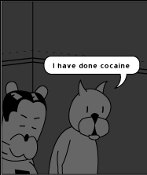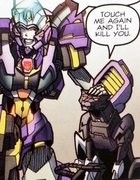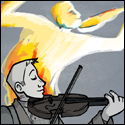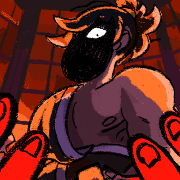|
Dawgstar posted:While Shadowrun is of course not immune to such things especially in later editions, Cyberpunk always felt really glaringly obvious that if you wanted to do combat you should play a Solo and everything else was just giving yourself a handicap. Shadowrun kinda has the opposite problem. It's a classless system, but there are definitely classes and you need to decide if you're gonna be a guns guy, a hacking guy, or a magic guy. They like to put out example PCS that are like "Face" or "Investigator" or "Infiltrator" and those are fine concepts, but from a gameplay standpoint they're secondary roles that demand less investment. Maybe you have a little less firepower because you took the cyberware that gives you super pheromones or Predator stealth instead of some more dermal plating. The problem that both games have is that metal is clearly better than meat. Cyberpunk is aware of this, while Shadowrun keeps suggesting you play something like the detective or gang member or weapons specialist with a lot of skills spread too thinly and barely any cyberware.
|
|
|
|

|
| # ? Jun 12, 2024 01:01 |
|
I vaguely remember that, years ago, a goon ran a post-apocalyptic Mario game. Did I dream this or is it real? What was it called? Is it archived somewhere other than, you know, The Archives?
|
|
|
|
Marpocalypse and no it's only in the Archives as far as I'm aware, rather far back too.
|
|
|
|
Tuxedo Catfish posted:literally the only way "designated combat class" can work is in a rules-light or narrative game where "fight" is just another verb with no special mechanical precedence I agree mostly but feel like your phrasing lacks nuance so I want to build on it. I donít think the game has to be super light to allow that, just flexible and with an understanding of its design. The Cutter from Blades, the Gunlugger from AW and the Hitter from Leverage work because they are both given opportunities to shine by the narrative and arenít just given nothing to do outside of fights. (Being actually the best at fighting is also a plus.) This does not go against the idea of how limiting being the fight person can be and how thatís bad design. Even 4e still gave lots of paragons paths that basically just jumping good or whatever.
|
|
|
|
The way PbtA and FitD does "best at fighting" is also very different from how crunchier/less narrative games do "best at fighting." In AW or Blades, being very good at fighting means three things:
In games that aren't fiction-first, you can't do these things without just making combat characters so much better at combat that non-combat characters can't hope to compete, and games like D&D, CP2020 or Shadowrun have it even worse because they (to various degrees) treat combat as a distinct area of play that you need to invest a large amount of very limited character resources into being good at, instead of treating combat as a universal language that everyone needs to have identical proficiency in. Lemon-Lime fucked around with this message at 09:58 on May 20, 2020 |
|
|
|
I wanna make fun of the fact there was a class that's gimmick was just that were a sellout and had money, but that would actually be pretty interesting in a narrative game. I'm also not sure 'there's a class that dominates combat' is as big a problem in cyberpunk 2020 as the typical 'your hacker is going to play a separate minigame away from all of you' problem that cyberpunk rpgs loved. But also I know in general non D&D games in the 90's tended to view splitting the party as good design. So no, the GM was supposed to run a game for 2 of you for 5-10 minutes then hop over to the other two, and finally GM for the other person. Like you'd all be working towards the same goals but investigating or doing different things. Edit: I think the other problem is it wasn't like 'oh if you're playing a solo you're better at combat than even 90% of the combat characters you'll see' which would also be a way of handling specialization. If your characters aren't the baseline of competency for encounters in their specialty, but the pinnacle it leaves room for others to contribute. Like if the whole party could contribute to a hacking encounter but only your decker got to do the ultra cool hacking. Coolness Averted fucked around with this message at 09:59 on May 20, 2020 |
|
|
|
Coolness Averted posted:Edit: I think the other problem is it wasn't like 'oh if you're playing a solo you're better at combat than even 90% of the combat characters you'll see' which would also be a way of handling specialization. If your characters aren't the baseline of competency for encounters in their specialty, but the pinnacle it leaves room for others to contribute. Like if the whole party could contribute to a hacking encounter but only your decker got to do the ultra cool hacking. You get the same problem either way - if the combat specialist isn't the baseline difficulty for combat, they will trivialise all combat; if the combat specialist is the baseline, no one will be able to contribute.
|
|
|
|
Lemon-Lime posted:You get the same problem either way - if the combat specialist isn't the baseline difficulty for combat, they will trivialise all combat; if the combat specialist is the baseline, no one will be able to contribute. Like in that case you couldn't really do the 'well the heavy hitters are in the encounter with your combat oriented characters' I mean I agree that in 90% of games that have 'combat dude' archetypes it's a problem, but it doesn't have to be.
|
|
|
|
Lemon-Lime posted:You get the same problem either way - if the combat specialist isn't the baseline difficulty for combat, they will trivialise all combat; if the combat specialist is the baseline, no one will be able to contribute. Hence why the best way to approach is the way D&D 4e and certain other tactical combat focused RPG's do it, by making everyone good at combat, or at least a specific segment of combat, which would actually be pretty easy to do for Shadowrun, as almost every major character archetype could be made to work in such a concept
|
|
|
|
There's a difference between being the best at fighting and being the best at combat. It's perfectly fine to have a class that's the best/worst at fighting, there's only a problem if that implies they're specced toward or away from defined chunks of the game. If the non-fight characters have non-fight based ways of equivalently contributing to combat encounters, or if defined combat encounters just aren't a thing so "fighting" is just "the guy holding the guards at the door while everyone else gets on with the job", then someone being the best at fighting is not a problem. Meanwhile the non-4e D&D fighter is a failure in every respect because they're the best at fighting while rapidly becoming the worst at combat, and also can't meaningfully non-combat. The 4e D&D fighter doesn't have the former issue but still has a lot of the latter.
|
|
|
|
drrockso20 posted:Hence why the best way to approach is the way D&D 4e and certain other tactical combat focused RPG's do it, by making everyone good at combat, or at least a specific segment of combat, which would actually be pretty easy to do for Shadowrun, as almost every major character archetype could be made to work in such a concept Yep, absolutely. If combat is the focus of the game, everyone should be able to contribute to combat equally. For something like Apocalypse World or CP2020, where combat is a strong likelihood but not the sole focus of the system, everyone should have a baseline level of combat competency that lets them contribute meaningfully including class-specific combat options that broaden what they can do, but the combat specialist should just have a broader range of options. The same extends to every other system (hacking, social interaction, property development, etc.). Lemon-Lime fucked around with this message at 11:41 on May 20, 2020 |
|
|
|
Len posted:I was in the middle of trying to convince a friend that we should go this year because housing should be super open when the news dropped Right? At the store MHR sold really well and then we got in Civil War and it was... less so and I knew to be worried. From what I gathered that was shenanigans on Marvel's side. That said check out Sentinel Comics when it drops. If you haven't taken a look, it really feels like the spiritual successor to MHR.
|
|
|
|
Lemon-Lime posted:Yep, absolutely. If combat is the focus of the game, everyone should be able to contribute to combat equally. Yeah, this is kind of my read on the situation. If you have a game where it's like, diplomats in the lead up to WW1, having one class that's just 'the best at combat' isn't really that big of a deal, but having one character that's just 'the best at talking' as like a Face then we've got serious issues. It's fine to have a game that privileges one set of mechanics over others (though not usually my preference), and it's fine to have a class that is the best at some mechanic or another, but it's not so fine to have a class that is just the best at the best mechanic.
|
|
|
|
The way I think about it is - how many times am I going to roll to fight in this game? If "fighting" is just one roll of the dice like in Apocalypse World, and it's one that's a voluntary choice (since the player can always choose to do a move that's not fighting instead), then there's not really any problem with one type of character dominating the fighting the party chooses to do. They're not spending any more of the party's time on it than they are on other types of move, they're not hogging the spotlight, so it's fine for them to shine in fighting situations. If you're making ten times as many fight rolls as you are non-fight rolls (like in many P&P games), then the game is dominated by fighting and all characters need to be equally involved in the fighting that occurs. If one character dominates the fighting in this kind of game, you've got a problem since they'll hog the spotlight during the activity that takes up most of the party's time. Gort fucked around with this message at 16:12 on May 20, 2020 |
|
|
|
Lemon-Lime posted:
What would you say are some good examples of these?
|
|
|
|
Xiahou Dun posted:I agree mostly but feel like your phrasing lacks nuance so I want to build on it. BitD is exactly what I meant when I said "rules light." It doesn't have a unique subsystem for fighting, fighting is just a narrative approach you can use to resolve a scene. In a situation like that it's fine for someone to be combat-specialized because combat isn't a separate mode of play. If you wanted a similarly poorly-designed character in BitD you'd need, like, a downtime specialist vs. a heist specialist.
|
|
|
|
Adam Vegas posted:What would you say are some good examples of these? Well, we've been talking about Gunlugger, and they're honestly THE most fighty playbook around, so it's good to work with an extreme example. First, stats. Gunluggers are all Hard+2, so they are really good at fighting, but there are stat sets with Weird+2, Sharp+2, and Cool+2, though all of those have Hot-2 and the only one with Hot-1 has no +2s other than Hard, so Gunluggers may be any of exceptionally intuitive, exceptionally perceptive, or exceptionally good under pressure, though never any good at diplomacy. In DND terms this is similar to "fighters always have 16 str, and can readily have 16 Wisdom, Dex/Int, or Con/Int with no loss in Str". Since raw stat rolls are extremely common and important in AW, this is a LOT of power outside of regular combat. Second, moves. Prepared for the Inevitable, gently caress This poo poo, and Battle-hardened are all really useful outside of combat, Battlefield Instincts applies to combat but has really weird use, and while Insano Like Drano and Bloodcrazed look like they're really just there for fights, they do have uses that don't involve fighting at all (after all, 'inflcting harm' can be done outside of combat). NOT TO BE hosed WITH comes up a lot because it's an extremely loving good fighting move, but it's also...just a fighting move. tl;dr - Gunlugger, pretty much by default, is automatically really good at fighting AND at least one other thing, and the Gunlugger is not just shooting but, depending on the moves you choose, can be good at healing, psychic poo poo, defending others, and running away.
|
|
|
|
Tulip posted:NOT TO BE hosed WITH comes up a lot because it's an extremely loving good fighting move, but it's also...just a fighting move. It is, but it's a fighting move so good it warps the broader narrative just having it. Any other gunlugger, you might throw the dice and toss twenty dudes at him to kick his rear end. A NOT TO BE hosed WITH gunlugger? It is time to get tricksy or diplomatic, because nobody has enough dudes for that.
|
|
|
|
Tulip posted:tl;dr - Gunlugger, pretty much by default, is automatically really good at fighting AND at least one other thing, and the Gunlugger is not just shooting but, depending on the moves you choose, can be good at healing, psychic poo poo, defending others, and running away. That's a cool rundown. How's the Battle Babe?
|
|
|
|
Adam Vegas posted:What would you say are some good examples of these? A good example of a Gunlugger move that is not (necessarily) combat oriented is gently caress this poo poo, which allows you to nope right out of a situation. Prepared for the inevitable is another good one, as it makes the Gunlugger a medic - a broadly useful capability outside of combat because you can rack up damage from all sorts of stuff (especially environmental dangers and errant Brainer moves). Jumping back to Shadowrun for a sec, I ran a ton of Shadowrun. In that time, I noticed a couple of things. First, the modifiers were the life's blood of that game. If you were diligent in applying them, the modifiers often ran into the 8-10+ range, and in combat this was especially true. Lowlight or thermographic imaging in most cases didn't entirely remove visibility modifiers, it just reduced them. Once you factored in target movement, shooter movement, range, cover, recoil, visibility, wound mods, etc. you were lucky if your target number was only a 10. This meant that a) contrary to being the "game breaking" thing so many GMs complained of, all that having wired reflexes did was make you waste ammo faster, and b) the winning strategy was to have the fight take place in an environment you controlled. But yeah, if you only remembered the -2 bonus from your smartgun link and had all your fights take place against stationary targets in open, well-lit environments, then the combat-oriented characters were going to run away with things and the opposition you needed to put forward to challenge them would be more or less instantaneously lethal to everyone else. But when you kept all the modifiers in mind I actually found "combat monster" characters to be incredibly short-lived, as they often had an inflated sense of their own invulnerability. I remember one specific incident where in a gunfight with a bunch of gangers a PC stepped out into a doorway covered by suppressive fire to take a shot. I asked him if he wanted to take any cover (which would have protected him but would have applied a slight penalty to his roll), and his response was, "Nah, I've got a Body of 13, I can take it." I even asked him my well-publicized "you are about to do something dumb" warning question - "Are you sure you want to do that?" He was adamant. Needless to say, he took a furious amount of damage, and even after his armor was applied he was still looking at a target number of like 11 on his damage resistance test. Statistically, you'll get a single 11 when rolling 13 exploding d6s, which is not enough to stage the damage down from "super loving deadly." So yeah, he stepped out into the doorway and got murdered more or less instantaneously - which is exactly what I would expect of anyone stepping into a full-auto "fatal funnel." Secondly, decking in early editions was absolutely the "separate mini-game" problem. But later editions tightened this up tremendously, and by SR3 you could cook through a system in a couple of rolls to get to the data or elevator control or whatever that you wanted. It had a ton of bookwork background you could do, but most of that was in calculating your bandwidth/intrusion factor rather than rolls you had to make in-play. I remember playing an intrusion decker (where you sneak onto the premises with the party and hack the system from the inside) and I think the longest hacking deal we had was short enough that the Street Sam and Physical Adept players smoked a single cigarette (which they were gonna pause the game to do whether I had poo poo to do or not). But getting it to run that quickly/smoothly required a fair amount of out-of-session prep on the part of both the GM and the decker player. Seeing those 1E character illos gives me serious nostalgia, though. SR1 had a splatbook that was all about news/media/music that helped support PCs as musicians or (my fave) investigative journalists that was really cool. I wish later editions had kept that sort of focus, because those were some really interesting variations on "raid corporate facility, fence loot" that SR tended to devolve to.
|
|
|
|
Ratoslov posted:It is, but it's a fighting move so good it warps the broader narrative just having it. Any other gunlugger, you might throw the dice and toss twenty dudes at him to kick his rear end. A NOT TO BE hosed WITH gunlugger? It is time to get tricksy or diplomatic, because nobody has enough dudes for that. This is absolutely true. I also can't quite figure out how to phrase this but it's kind of got its own intrinsic drawbacks? When you take NOT TO BE hosed WITH, you just have this one dude who distorts every balance of power situation they walk into because they're so outrageously more dangerous than any other person around. Everything becomes way weirder and edgier, or at least that's how the three groups I've played AW with have interpreted that rule more-or-less independently. That said, Hardholders can absolutely take on even a NOT TO BE hosed WITH gunlugger, because Hardholder is the most insane class and I love it to death. Dawgstar posted:That's a cool rundown. How's the Battle Babe? The thing that my friends and I pointed at in Battlebabe immediately is their stat sets. All of them have Cool+3, which is nuts. No other playbook gets +3 to start in anything, and it's crazy powerful - +3 in AW means that you have a 58% chance of a 10+, and only an 8% chance of a 6-. Where this gets extremely funny and cool is that all of them have Hard=0 or lower (one has Hard-2!). The most obvious move interaction to deal with this is the classic 'sub one stat for another' move - Ice Cold means you no longer roll +Hard when you go aggro, but instead +Cool against NPCs and +Hx against PCs. However, this does NOT affect seize by force, the more normal combat move. All this together means Battlebabes are great at starting poo poo, but not great at ending poo poo. Taking Perfect Instincts and a Sharp+1 set might allow you to make up for this quite handily - it's pretty straightforward to read a sitch in a combat scenario, and getting +2 on rolls because of it can forgive a lot of sins, plus its useful in basically any scenario where you can justify spending time and rolls on looking around. However, you're automatically giving up a certain amount of narrative agency if you follow through. Dangerous & Sexy gives you another means of dealing with conflicts, and can shut down a lot of problems just by being super Hot. Visions of Death is the last move that substantially changes how you fight and in probably the weirdest way, and has become a classic to rip-off in PBTA hacks, because it means it kind of doesn't MATTER how you fight, you're just outright seizing the narrative from the MC. Part of what's cool about these 3 moves is that they're somewhat anti-synergistic - each of the stat blocks orients you toward one of these, except of course for the C3H-2H1S1W1 block, which has Hard-2 and is thus a REAL fuckin choice to make. The remaining moves, Merciless and Impossible Reflexes, simply make you more deadly and more durable in straightforward ways. All of this is largely taking for granted that you want to be a dangerous Battlebabe, and to be fair, it's "Battle" for a reason. You could definitely make a less combat oriented Battlebabe - do something under fire is an extremely versatile action for any troublemaker, and Perfect Instincts is good for basically any scenario under the sun, so you're good at causing problems and surviving them, even if you don't plan on killing anybody who tries to stop you.
|
|
|
|
That was informative and fun to read. Thanks!
|
|
|
|
I've toyed with the idea of having NTBFW negate a level of gang size instead of making the Gunlugger count as a small gang themselves. This keeps the thematic nature of the move while making the Gunlugger less ridiculous in fights where there isn't a gang involved, and actually making it more interesting if the Gunlugger has allies, because now they get to fight a small gang on equal footing by virtue of the Gunlugger being in the fight. This makes it easier to have NPCs challenge Gunluggers in a fight without the rest of the players being significantly handicapped, which makes it easier to GM the game. The fiction is also funnier: instead of just being more powerful than anyone you fight, you're so powerful that merely participating in a fight prevents enemies from leveraging their numbers and coordination because they're too busy making GBS threads bricks. Lemon-Lime fucked around with this message at 21:19 on May 20, 2020 |
|
|
|
Lemon-Lime posted:I've toyed with the idea of having NTBFW negate a level of gang size instead of making the Gunlugger count as a small gang themselves. This keeps the thematic nature of the move while making the Gunlugger less ridiculous in fights where there isn't a gang involved, and actually making it more interesting if the Gunlugger has allies, because now they get to fight a small gang on equal footing by virtue of the Gunlugger being in the fight. This makes it easier to have NPCs challenge Gunluggers in a fight without the rest of the players being significantly handicapped, which makes it easier to GM the game. Ha, we've actually done that before, off of the argument that "in battle" is a more narrow trigger than "in combat." Dawgstar posted:That was informative and fun to read. Thanks! It was fun to write. The AW playbooks have a real artfulness to the interaction between mechanics and fiction, and have tradeoffs that feel, well, really cool.
|
|
|
|
Tulip posted:All this together means Battlebabes are great at starting poo poo, but not great at ending poo poo. 
|
|
|
|
this also makes them great to point in the direction of other PCs, if you can somehow convince them that it's a good idea to go mess them up.
|
|
|
|
Lemon-Lime posted:I've toyed with the idea of having NTBFW negate a level of gang size instead of making the Gunlugger count as a small gang themselves. This keeps the thematic nature of the move while making the Gunlugger less ridiculous in fights where there isn't a gang involved, and actually making it more interesting if the Gunlugger has allies, because now they get to fight a small gang on equal footing by virtue of the Gunlugger being in the fight. This makes it easier to have NPCs challenge Gunluggers in a fight without the rest of the players being significantly handicapped, which makes it easier to GM the game. Burned Over does this with the Volatile (combination Battlebabe/Gunlugger). Hold Your Own lets you count as a small gang when you're facing a gang. I think it works fine as is in Apocalypse World though. The Gunlugger is like John Wick - there's a reason he's constantly going up against groups of people. In my experience, if a Gunlugger has a chance to fight a single person the question isn't really "Will they win without getting hurt too bad?" it's "Is the Gunlugger willing to kill this person regardless of the consequences?"
|
|
|
|
Heliotrope posted:"Is the Gunlugger willing to kill this person regardless of the consequences?" This is a huge distinction between Apocalypse World and, well, most other games that feature combat. AW doesn't really give a poo poo what happens in combat; the question isn't "how did you win or lose" but "what consequences do you get/are you willing to accept for winning?" The dice are only there to provide a framework of how much you get to control the fiction vs. how much the MC does.
|
|
|
|
Ilor posted:And this is what makes the Battlebabe such a hilariously awesome playbook. They are drama-bombs waiting to happen. You just know that at any minute they're going to cause all hell to break loose, and while it's likely that they'll walk out of it without a scratch (especially if they take impossible reflexes, everyone else is going to be left scrambling. So yeah, there'll be a gunfight, but the bad guy will live, collateral damage will happen, and everyone else will pay the price. It's And the Battlebabe will look great doing it?
|
|
|
|
Zurui posted:This is a huge distinction between Apocalypse World and, well, most other games that feature combat. AW doesn't really give a poo poo what happens in combat; the question isn't "how did you win or lose" but "what consequences do you get/are you willing to accept for winning?" The dice are only there to provide a framework of how much you get to control the fiction vs. how much the MC does. Dogs In The Vineyard is way more explicit about it, what with the 'you can give up, or you can take on more consequences,' and it's a philosophy I really love. It's fairly common on reddit to have somebody come into DW with "how do I make combat more lethal" and really the issue is that lethality isn't the consequence your players should be worrying about. Dying is easy, living with alienating your family, betraying your movement, etc. is much harder.
|
|
|
|
Halloween Jack posted:Shadowrun kinda has the opposite problem. It's a classless system, but there are definitely classes and you need to decide if you're gonna be a guns guy, a hacking guy, or a magic guy. They like to put out example PCS that are like "Face" or "Investigator" or "Infiltrator" and those are fine concepts, but from a gameplay standpoint they're secondary roles that demand less investment. Maybe you have a little less firepower because you took the cyberware that gives you super pheromones or Predator stealth instead of some more dermal plating. Ilor posted:Jumping back to Shadowrun for a sec, I ran a ton of Shadowrun. In that time, I noticed a couple of things. First, the modifiers were the life's blood of that game. If you were diligent in applying them, the modifiers often ran into the 8-10+ range, and in combat this was especially true. Lowlight or thermographic imaging in most cases didn't entirely remove visibility modifiers, it just reduced them. Once you factored in target movement, shooter movement, range, cover, recoil, visibility, wound mods, etc. you were lucky if your target number was only a 10. This meant that a) contrary to being the "game breaking" thing so many GMs complained of, all that having wired reflexes did was make you waste ammo faster, and b) the winning strategy was to have the fight take place in an environment you controlled. But yeah, if you only remembered the -2 bonus from your smartgun link and had all your fights take place against stationary targets in open, well-lit environments, then the combat-oriented characters were going to run away with things and the opposition you needed to put forward to challenge them would be more or less instantaneously lethal to everyone else.
|
|
|
|
Halloween Jack posted:The problem that both games have is that metal is clearly better than meat. Cyberpunk is aware of this, while Shadowrun keeps suggesting you play something like the detective or gang member or weapons specialist with a lot of skills spread too thinly and barely any cyberware. It's interesting you mention the Face type character as I was playing an elven version in 3E which when they started the stuff like Tailored Pheremones as... not cyberware but the other stuff that I can't remember off the top of my head so even there 'metal' helped. And they got pretty good at the talking thing. Although even there it didn't compare to 4E's 'Pornomancer' as I believe it was delightfully called.
|
|
|
|
Gobbeldygook posted:Skill Guy is a completely valid archetype in Shadowrun. Everyone should have a ranged combat skill (and perception and stealth and in 4e+ a defense skill), but not being super-invested in the combat or hacking minigames is a valid choice. Being the guy with First Aid, electronics skills, social skills, one vehicle skill, an unarmed flying drone, and lots of contacts will give you as much time in the spotlight in most games as a gunbunny. The one time I played Shadowrun was as a Face in Humbug's South African minj-campaign a few years bag. I never pulled a trigger, but if I could get a cell signal or even just a word in edgewise, things were going to go our way. Even when confronted with a, excuse me if I get the terminology wrong, Level 10 Toxic Spirit that had just disabled a Block II Arleigh Burke-class destroyer.
|
|
|
|
Dawgstar posted:It's interesting you mention the Face type character as I was playing an elven version in 3E which when they started the stuff like Tailored Pheremones as... not cyberware but the other stuff that I can't remember off the top of my head so even there 'metal' helped. And they got pretty good at the talking thing. Bioware. Twelve dice on social checks with Tailored Pheremones didn't help much when you still went splat at the drop of a hat, unfortunately. Mil-spec combat armor was the real bugbear I tripped over, on a related note. I ended up making a character that was invulnerable but otherwise useless, and anything that could affect my mall ninja would instantly gib the rest of the team.
|
|
|
|
CitizenKeen posted:MHRP is so bittersweet to me; always glad to hear a new good thing that came from it. I can only imagine.  You were a dev, right? You were a dev, right?
|
|
|
|
TK_Nyarlathotep posted:I can only imagine. Haha, oh no. I have nothing to do with Cortex, other than a nostalgic fondness for a solid Firefly campaign a few years back. MHR went pear shaped about the same month I discovered it. Cortex is a system I wish got more love and more importantly more luck. I hope this Fandom thing really works out, because Cortex should be as big as Fate or *World. But no, I'm not involved with it at all.
|
|
|
|
I've been trying to plan a Cortex game, but I haven't really had the time to get back to making my datafile.
|
|
|
|
Ilor posted:Jumping back to Shadowrun for a sec, I ran a ton of Shadowrun. In that time, I noticed a couple of things. First, the modifiers were the life's blood of that game. If you were diligent in applying them, the modifiers often ran into the 8-10+ range, and in combat this was especially true. Lowlight or thermographic imaging in most cases didn't entirely remove visibility modifiers, it just reduced them. Once you factored in target movement, shooter movement, range, cover, recoil, visibility, wound mods, etc. you were lucky if your target number was only a 10. This meant that a) contrary to being the "game breaking" thing so many GMs complained of, all that having wired reflexes did was make you waste ammo faster, and b) the winning strategy was to have the fight take place in an environment you controlled. But yeah, if you only remembered the -2 bonus from your smartgun link and had all your fights take place against stationary targets in open, well-lit environments, then the combat-oriented characters were going to run away with things and the opposition you needed to put forward to challenge them would be more or less instantaneously lethal to everyone else. Thank you for sharing this story! I enjoyed it a lot and the peek into the mechanics is really cool.
|
|
|
|
I think it was in one of this thread's iterations where someone ran a massive Shadowrun campaign with a rotating player group at their college, where whenever a character died their player was out and had to queue to re-enter the campaign with a new character. Because of the risk of death, the initial players all made combat monsters, who proceeded to chunk it and get killed off in short order, because even a good fighter can't beat the odds when everything comes down to a firefight. The group only stabilised once the players were canny enough to make characters without a combat focus and who avoided conflict as much as possible.
|
|
|
|

|
| # ? Jun 12, 2024 01:01 |
|
Zeerust posted:I think it was in one of this thread's iterations where someone ran a massive Shadowrun campaign with a rotating player group at their college, where whenever a character died their player was out and had to queue to re-enter the campaign with a new character. Because of the risk of death, the initial players all made combat monsters, who proceeded to chunk it and get killed off in short order, because even a good fighter can't beat the odds when everything comes down to a firefight. The group only stabilised once the players were canny enough to make characters without a combat focus and who avoided conflict as much as possible.
|
|
|





































